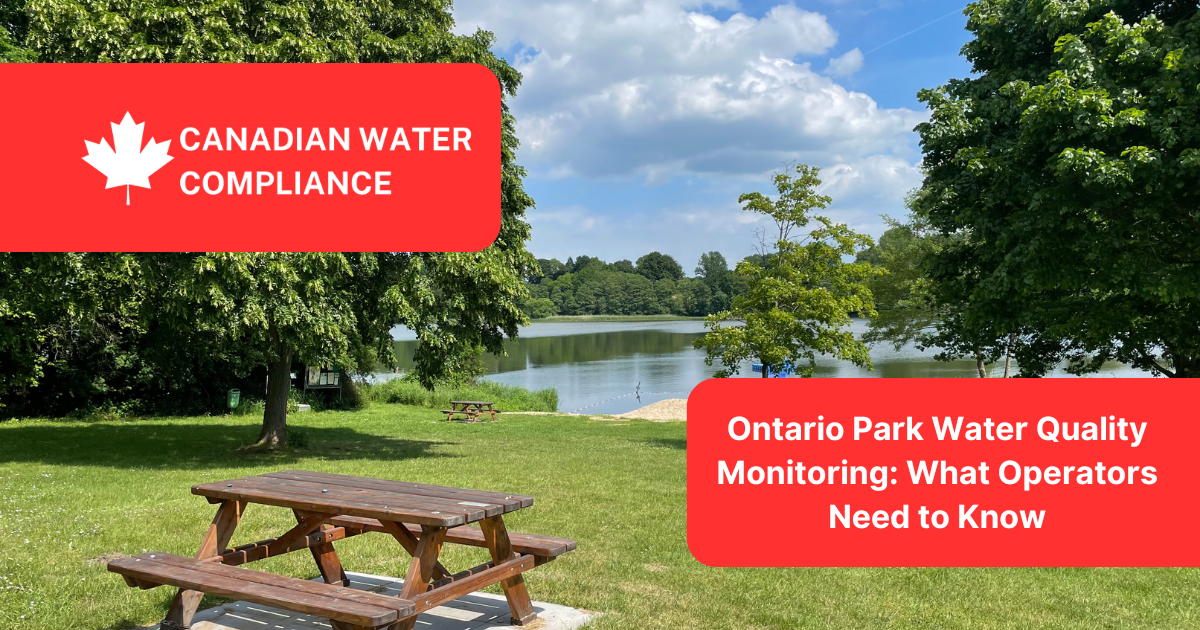
Written By: Canadian Water Compliance | On
Ontario’s parks—whether provincial, municipal, or privately operated—play a vital role in public health, recreation, and environmental protection. But with thousands of visitors each year, the quality of water in these parks isn’t just a matter of environmental concern—it’s a public health obligation.
From splash pads and beaches to drinking fountains and natural water sources, regular water testing and monitoring is critical to ensuring visitor safety and complying with provincial standards. Here’s what park operators and managers in Ontario need to know about water quality responsibilities.
Parks typically feature multiple water uses and touchpoints—each with its own set of risks. These can include:
Swimming beaches with potential for E. coli or cyanobacterial blooms
Public drinking water systems (especially those using wells or surface water)
Splash pads or wading pools that may require chlorination and microbiological testing
Irrigation or natural ponds where contamination can impact nearby ecosystems or human contact
Without consistent monitoring, waterborne pathogens and chemical contamination can go unnoticed, putting visitors at risk and exposing municipalities or property managers to legal and reputational damage.
Depending on their infrastructure and water services, the following types of parks may be subject to water testing:
Municipal parks with splash pads, water fountains, or beach access
Provincial parks regulated under specific ministry guidelines
Private parks or campgrounds that offer water to the public under a Small Drinking Water System
Conservation areas with natural water features or public restrooms
In most cases, monitoring isn’t just recommended—it’s required by law under provincial legislation like O. Reg. 319/08 (for small drinking water systems), O. Reg. 170/03 (for municipal systems), or Recreational Water Protocols under the Ontario Public Health Standards.
Specific testing schedules are usually determined by a risk assessment or local public health requirements, but generally include:
E. coli and Total Coliforms: Common indicators of fecal contamination—often required on a weekly or biweekly basis for swimming or drinking water
Cyanobacteria (blue-green algae): Important for lakes, ponds, or beaches—especially during warmer months
Free chlorine levels: For splash pads or treated water systems
Nitrate/Nitrite and Sodium: Important for drinking water safety
pH, turbidity, and other physical parameters depending on the use and source
Park water quality falls under multiple regulatory frameworks depending on the water’s purpose and source:
Drinking Water: Small Drinking Water Systems (SDWS) must follow O. Reg. 319/08, including regular microbiological and chemical testing
Beach Water: Regulated under the Ontario Recreational Water Protocol, with E. coli as the primary risk indicator
Splash Pads/Wading Pools: Managed by local health units under the Ontario Public Pools Regulation (O. Reg. 565)
Operators must also coordinate with Public Health Units, who often perform inspections, risk assessments, and testing audits.
Failing to properly monitor water quality can result in:
Boil Water Advisories or beach closures
Fines or penalties under the Safe Drinking Water Act
Health risks to children, seniors, or immunocompromised visitors
Reputational harm for park operators, municipalities, or tourism departments
Even perceived lapses in water safety can damage public trust and reduce park usage.
We help Ontario park operators and municipalities stay compliant and keep visitors safe through:
Certified water sampling and accredited lab testing
Ongoing monitoring programs tailored to seasonal or year-round operations
Coordination with Public Health Units and regulatory bodies
Emergency response sampling in case of contamination
Risk assessment consulting for new or existing park infrastructure
Whether you’re managing a municipal splash pad or a remote beach, Canadian Water Compliance provides the testing expertise you need to protect the public and meet regulatory requirements.